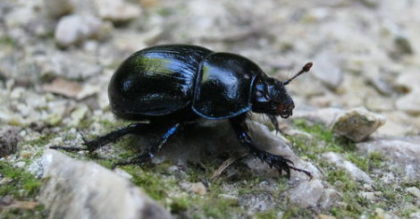
 )
)Last week we got to see from the perspective of a dog exploring in the woods. This week I’m even more excited about the possibility of seeing the world from a beetle’s perspective. We already know that at least some insects can see in the ultraviolet spectrum and some flowers have patterns we cannot see to attract pollinators who can them. We also know that the compound eyes of insects offer a very different view than our binocular vision. But with new miniature self-powered cameras, we can hook a camera up to beetles or comparably sized insects and see where they go, what they do, and with whom they do it. Play the footage back through a VR rig and you basically have the closest to an Ant-Man experience we are likely to achieve for some time.
Such cameras are not simply simulating superheroics, of course. They have potential applications for serious etymology. In fact, simply constructing and operating the camera demonstrates an aspect of the energetics of vision that helps to explain some of the adaptive tradeoffs. Vision is costly and one potential savings is to have a smaller field of vision and the ability to pan it around without moving the whole body. This camera is able to realize such an energy savings for robots on the same scale, suggesting insects may in fact be getting similar benefits. Such energy efficient cameras may also be useful in robotics applications independent of etymology as well.
What happens at such tiny scales may not usually seem all that relevant to our human scale lives, although perhaps recent events are persuasive otherwise. In reality, the global impact of any organism is not necessarily proportional to its physical size. Research into modern Homo sapiens genomes as well of those of ancient Neanderthals and Denisovans and also current apes reveals changes which substantially changed our relationship to bacteria and viruses. Both the ways in which they could infect our cells and the ways in which our immune system responds were impacted by a mutation resulting in the loss of a single gene.
That gene catalyzed the synthesis of N-Glycolylneuraminic acid (Neu5Gc), a small molecule that can be found on the outside of many mammalian cells. But not our cells, because we don’t have the gene to make it, and so our cells have a slightly different molecule in its place, a molecule many other mammals turn into Neu5Gc. Bacteria don’t have Neu5Gc on their exteriors, so its presence was a good way for mammalian immune systems to differentiate self cells from invaders. It was also a good molecule for bacteria and viruses to use to recognize host cells. The shift away from Neu5Gc in our ancestors may have provided some instrinsic immunity to some pathogens as a result, but also created a situation for pathogens to adapt specifically to us. As a result, present day apes are not as susceptible to a number of infections which are serious to us, despite being the living organisms most similar to us.
Since different pathogens affect us and apes differently, and since our immune systems respond differently than theirs, we can only learn so much from studies in apes. So to develop a vaccine against, say, SARS-CoV-2, we ultimately need to study the vaccine in humans. We might imagine or hope that our close similarity to chimpanzees might obviate human studies, but because of that one mutation two million years ago (and possibly other changes as well), we don’t have that option. And so, on Monday two different groups started enrolling patients in phase 3 clinical trials of their separate vaccine candidates, the last and also largest and most time consuming step to achieve licensing for use in human populations. We’ve reached this point with remarkable speed. While we may regret the loss of the gene for making Neu5Gc and making us more susceptible to this particular virus, we can also be grateful that we do not need to wait generations for natural selection to come up with a response but instead we can react within the span of a year.
Andy has worn many hats in his life. He knows this is a dreadfully clichéd notion, but since it is also literally true he uses it anyway. Among his current metaphorical hats: husband of one wife, father of two teenagers, reader of science fiction and science fact, enthusiast of contemporary symphonic music, and chief science officer. Previous metaphorical hats include: comp bio postdoc, molecular biology grad student, InterVarsity chapter president (that one came with a literal hat), music store clerk, house painter, and mosquito trapper. Among his more unique literal hats: British bobby, captain’s hats (of varying levels of authenticity) of several specific vessels, a deerstalker from 221B Baker St, and a railroad engineer’s cap. His monthly Science in Review is drawn from his weekly Science Corner posts — Wednesdays, 8am (Eastern) on the Emerging Scholars Network Blog. His book Faith across the Multiverse is available from Hendrickson.

Leave a Reply